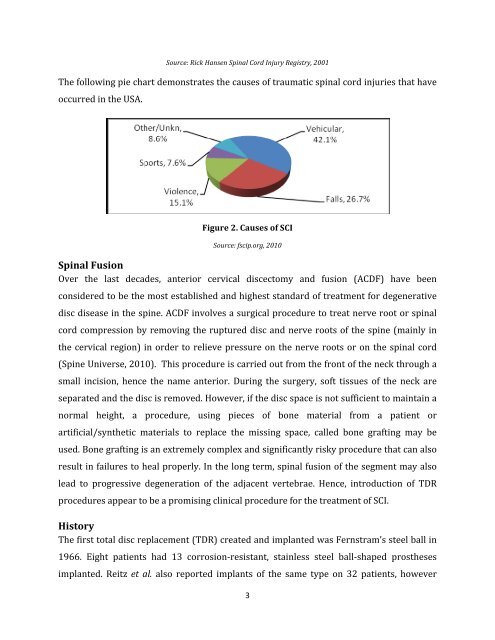Intervertebral Disk Replacement - Keivan Anbarani's Electronic ...
Intervertebral Disk Replacement - Keivan Anbarani's Electronic ...
Intervertebral Disk Replacement - Keivan Anbarani's Electronic ...
Create successful ePaper yourself
Turn your PDF publications into a flip-book with our unique Google optimized e-Paper software.
Source: Rick Hansen Spinal Cord Injury Registry, 2001<br />
The following pie chart demonstrates the causes of traumatic spinal cord injuries that have<br />
occurred in the USA.<br />
Figure 2. Causes of SCI<br />
Source: fscip.org, 2010<br />
Spinal Fusion<br />
Over the last decades, anterior cervical discectomy and fusion (ACDF) have been<br />
considered to be the most established and highest standard of treatment for degenerative<br />
disc disease in the spine. ACDF involves a surgical procedure to treat nerve root or spinal<br />
cord compression by removing the ruptured disc and nerve roots of the spine (mainly in<br />
the cervical region) in order to relieve pressure on the nerve roots or on the spinal cord<br />
(Spine Universe, 2010). This procedure is carried out from the front of the neck through a<br />
small incision, hence the name anterior. During the surgery, soft tissues of the neck are<br />
separated and the disc is removed. However, if the disc space is not sufficient to maintain a<br />
normal height, a procedure, using pieces of bone material from a patient or<br />
artificial/synthetic materials to replace the missing space, called bone grafting may be<br />
used. Bone grafting is an extremely complex and significantly risky procedure that can also<br />
result in failures to heal properly. In the long term, spinal fusion of the segment may also<br />
lead to progressive degeneration of the adjacent vertebrae. Hence, introduction of TDR<br />
procedures appear to be a promising clinical procedure for the treatment of SCI.<br />
History<br />
The first total disc replacement (TDR) created and implanted was Fernstram’s steel ball in<br />
1966. Eight patients had 13 corrosion-‐resistant, stainless steel ball-‐shaped prostheses<br />
implanted. Reitz et al. also reported implants of the same type on 32 patients, however<br />
3


